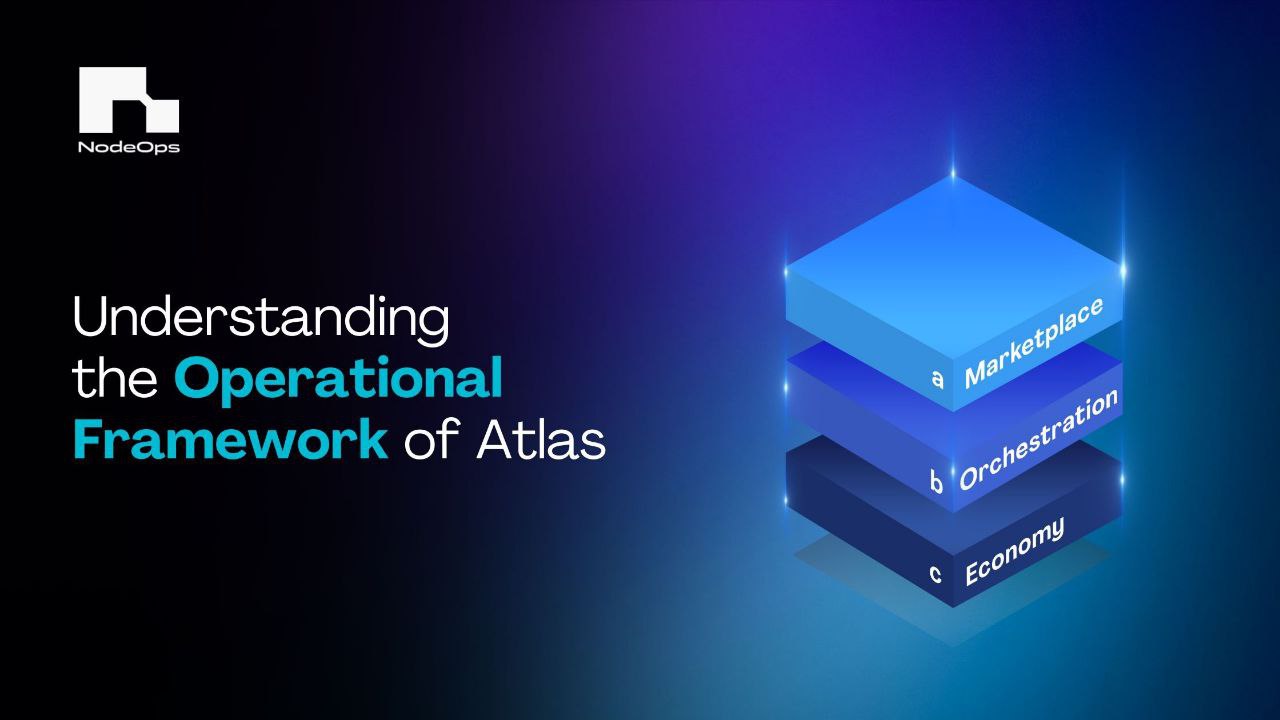We at NodeOps created Atlas to bring decentralisation and economic security to node infrastructure for blockchains and protocols. In this article, we will present the "Three Layers" that define the operational framework in which Atlas has been designed.
If you are new to NodeOps and Atlas, we recommend reading this blog to familiarise yourself with us and why we are building Atlas.
The Three Layers
Atlas has been designed around three main focus areas to effectively address the challenges we see with current node infrastructure provisioning and transform NodeOps into a permissionless, decentralised, secure infrastructure marketplace for the Web3 ecosystem.
These three focus areas form the three layers, creating an operational framework for delivering on this mission.
Figure1: The Three Layers of Atlas
Marketplace
To serve the growing demand within the Web3 space for robust and reliable node infrastructure, an open and permissionless marketplace where blockchains, protocols, dApps, and AVS can share their node networks and economic security requirements is needed.
With NodeOps, Web3 projects will have access to a unified storefront for all their infrastructure needs, where they can create proposals for operator and security bootstrapping.
The marketplace will be permissionless to remove the concentration of decision-making power and replace it with governance based on on-chain voting by the NodeOps token delegators, thereby reducing the scope of malpractice and manipulation.
Figure2: Permissionless Marketplace
From the supply side, Atlas will enable a more diverse and decentralised pool of compute infrastructure providers for running nodes.
Anyone and everyone can join this pool and provide the requisite hardware and economic security, be it solo or DVT validators, Operators on EigenLayer, or other decentralised or centralised compute providers.
Initially, onboarding into this provider pool will be whitelisted to ensure a smooth start.
Orchestration
Orchestration is at the core of Atlas' operations. It provides all stakeholders with a seamless, friction-free, and reliable overall user experience.
The Atlas AVS running on EigenLayer is responsible for this orchestration. It oversees critical functions related to provider onboarding, node deployment, monitoring active nodes, and distributing rewards and penalties.
Figure3: Orchestration
New providers entering through the marketplace are verified for reliability and availability before they are added to the pool. The Atlas AVS selects the right infrastructure provider from the pool and schedules node deployment. Once deployed, the node is actively monitored with the help of an independent network of light clients called the NodeWatch network. The entire process is kept honest and reliable by ensuring that the providers are rewarded for doing their job correctly and penalised for malpractice.
Sustainable Economy
Atlas offers a sustainable economic model for value capture and distribution that relies on $NODE as its primary source of hyper-yield optimiser. The concept provides an industry-leading set of incentives for each stakeholder, ensuring the network's robustness and efficiency.
Atlas uses the current restaking infrastructure via EigenLayer and the $NODE token in a dual staking strategy, which adds an extra degree of dependability, security, and trust.
Figure4: Sustainable Economy
The protocol understands that all stakeholders must be incentivised for active engagement to maintain the network's effectiveness. Slashing is a punitive measure for misconduct or noncompliance and guarantees that providers follow the protocol.
Conclusion
The operational framework captures our approach to solving one of the most critical challenges we face in Web3 today in a way that fosters growth, inclusivity, and transparency. We hope the information in this blog will inspire other node infrastructure providers to ideate on how they would want to join us in reaching our collective north star of a decentralised and secure Web3 ecosystem.


